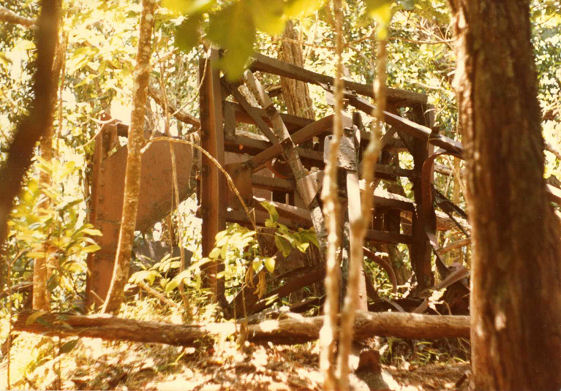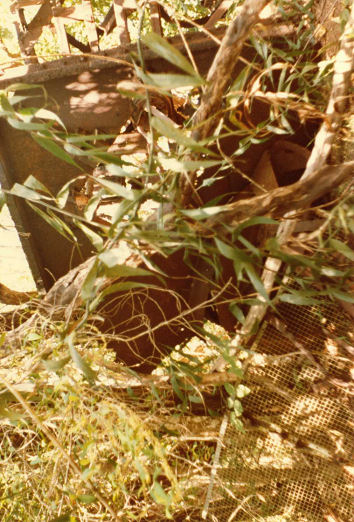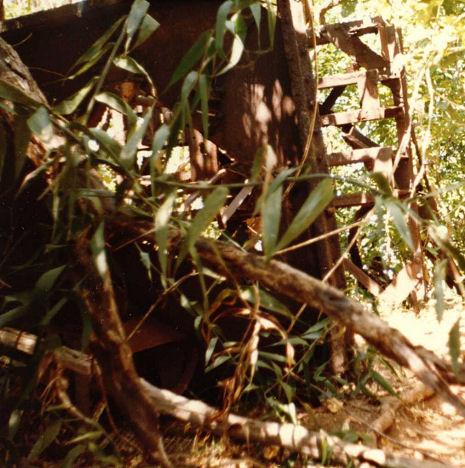NO. 27 RADAR STATION RAAF
TOWNSVILLE, QLD
DUNK ISLAND, QLD
DURING WWII
![]()
Cpl. Ken Hogan of Base Radio MCS, RAAF Base Townsville is researching No. 27 Radar Unit that was based in Townsville and Dunk Island during WW2. He would like to find the sites it was located at and visit them. The Dunk Island Airfield was often visited by 5 Communication Unit RAAF brining visitors and Safe Hand mail deliveries.
While holidaying on the island in 1984 Geoff Russell walked to the site of the former No. 27 Radar RAAF and was able to photograph the rather deteriorated remains of the radar unit. Geoff was told that the site suffered this damage during a cyclone. The site is an easy walk from the resort to the top of the peak on the island.
27 Radar Station was formed at Townsville in north Queensland on 5 October 1942. Pilot Officer W. H. O'Donnell A5572, started as the Commanding Officer on 6 October 1942. The acquisition of barracks, stores and equipment commenced immediately in Townsville. Various personnel were posted to the unit in the following few weeks and the Strength of 27 Radar Station on 31 October 1942 was one Officer and fourteen Other Ranks.
27 Radar Station departed Townsville by rail on on 6 November 1942, arriving at Tully on 7 November 1942. Strength at that time stood at one Officer and 18 Other Ranks. The journey to Dunk Island was completed on the same day by motor vehicle and launch. Various buildings previously taken over by the RAAF were occupied. An inspection of the Power House, Transmitter and Receiver buildings and various other minor installations were made the following morning. A telephone line was installed and communication established between the Orderly Room, Power House and Operations Room.
A number of members contracted dengue fever during the first week on the island. Two of them were sent to the Tully District Hospital for treatment. The rest were treated on the island. The lack of a Nursing Orderly on the island was a noticeable handicap.
A site was selected for the second Power House and the Cardwell Shire Council commenced constructing the Power House building. The Department of the Interior ordered the work to stop two days later. The Cardwell Shire Council workers left the island on 27 November 1942. Regular searching commenced in the Operations Room on 9 November 1942 but reports were not being sent through to No. 9 (Mobile) Fighter Sector Headquarters as it was not yet operational.
Eight airmen were posted to the Unit during November 1942 bringing the Strength at 30 November 1942 at one Officer and twenty six Other Ranks.
The first series of calibration flights for the radar were carried out during December 1942 with results being very poor. Approval was obtained from the D.R.S. to carry out lopping of trees around the radar antennae array. Continuous operation was established with No. 9 (Mobile) Fighter Sector Headquarters and 27 Radar Station became fully operational on 25 December 1942.
On 31 December 1942, the rotor of the alternator in the Lister generating plant was observed to be rubbing on the stator lamination iron and it was decided to shut it down and dismantle the unit. No. 9 (Mobile) Fighter Sector Headquarters and North Eastern Area N.E.A. were advised by signal at 1230 hours on 31 December 1942 of the situation. The alternator was dismantled and examined. The alternator was reassembled and coupled back to the engine and power was restored at 0330 hours on 5 January 1943.
The USS Phoenix escorted by two destroyers arrived off the island on 18 January 1943. The Commander of the USS Phoenix visited 27 Radar Station on 19 January 1943. Major Darnke and a party of 44 US Marines camped on the island for some training exercises. Sergeant Theodore Leonard Hundsness of the U.S.M.C. was lost during maneuvers on 20 January 1943. Search parties were arranged on 21 January 1943 to search the island.
The Radar Operations Room was off the air at 2130 hours on 21 January 1943 due to failure of the transformer for power supply to the Cathode Ray tube. It was on the air again at 0300 hours on 22 January 1943 using old equipment from the amplifier. It failed again at 0630 hours. Temporary equipment was obtained from Tully and it was on the air again at 2215 hours.
USS Phoenix and the two destroyers departed the area at 0755 hours on 23 January 1943. The body of Sgt Hundsness U.S.M.C. was found by Corporal Norman Frank. Hoschke RAAF 60939 and others at approximately 1000 hours on 24 January 1943 floating in deep water close to the shore on the northern shore of the island. A trip was made to Tully and the US Naval Liaison Officer at Townsville was informed by phone.
The body of Sgt Hundsness U.S.M.C was interred at 1800 hours on 24 January 1943 by the Commanding Officer according to the service laid down by RAAF HQs. An RAAF escort and salute was provided. On 25 January 1943, Sergeant Evans and Sergeant Dent of the U.S. Graves Registration arrived on the island and the body was disinterred on 26 January 1943 and relocated to Townsville for burial in the US Cemetery at Belgian Gardens.
USS Phoenix and destroyer escort returned on 27 January 1943 and the Commanding Officer of the USS Phoenix was provided with a report on the finding of the body of Sgt Hundsness and his eventual burial in Townsville.
The Army Supply vessel "Melbidin" and Army Patrol vessel "AS 24" visited the island. The latter under W/O Mansen was enroute to Milne Bay via Cairns.
USS Phoenix and its destroyer escort departed the area at 0700 hours on 31 January 1943.
HMAS Hobart and a destroyer arrived off Dunk Island on 31 January 1943. The Commanding Officer of 27 Radar Station visited HMAS Hobart on 1 February 1943. Signallers came ashore from HMAS Hobart to advise the ship in the case of any unidentified aircraft being detected. They also handled signal traffic with Fighter Sector HQs at the request of the Captain of HMAS Hobart.
HMAS Hobart departed the area on 6 February 1943. USS Phoenix arrived again on 6 February 1943. Similar arrangements were made with regard to unidentified aircraft.
Captain Bell arrived to assess compensation for the island's owner for the RAAF occupation of the island.
On 15 February 1943 HMAS Hobart with its escorting destroyers plus the supply ship Merkur arrived off Dunk Island again. They departed the area on 23 February 1943.
Strength for 27 Radar Station at 28 February was one Officer and thirty four Other Ranks.
A party of camoufleurs arrived on Dunk Island on 1 march 1943 under Mr. Pope, of the Department of Interior.
Task Force 44 anchored off Dunk Island on 4 March 1943. During their stay off the island, Ensign Larkin off USS Phoenix was lost on the island. He was found uninjured the morning after the squadron left. The Naval Officer in Charge Cairns (NOIC Cairns) was advised and Ensign Larkin was picked up by a destroyer on 10 March 1943. Rear Admiral Crutchley, Commander of the Task Force visited the island during the visit of the ships.
F/O Bullen and P/O F.W. Sharp arrived on 22 March 1943 and calibration flights were carried out under the supervision of F/O Bullen on 24 and 25 March 1943.
F/Lt Kelly, Roman Catholic Chaplain and F/Lt Cranitch, Area Rehabilitation Officer arrived at the unit on 20 March 1943. F/Lt Cranitch gave a presentation on Rehabilitation to members of 27 Radar Station.
RESTART PAGE 8

Photo:- Geoff Russell
Remnants of 27 Radar site on Dunk Island in 1984

Photo:- Geoff Russell
Remnants of 27 Radar site on Dunk Island in 1984

Photo:- Geoff Russell
Remnants of 27 Radar site on Dunk Island in 1984
ACKNOWLEDGEMENT
I'd like to thank Ken Hogan and Geoff Russell for for their assistance with this home page.
Can anyone help me with more information?
"Australia @ War" WWII Research Products
|
© Peter Dunn 2015 |
Please
e-mail me |
This page first produced 16 August 2002
This page last updated 13 January 2020